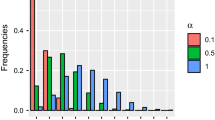Abstract
A general method for the analysis of ecological count data with extra zeros is presented using a Markov birth process representation of discrete distributions. The method uses a non parametric formulation of the birth process to model the residual variation and therefore allows the data to play a greater role in determining an appropriate distribution. This enables a more critical assessment of covariate effects and more accurate predictions to be made. The approach is also presented as a useful diagnostic tool for suggesting appropriate parametric models or verifying standard models. As an ill ustrative example, data describing a bundance of a species of possum from the montane ash forests of the central highlands of Victoria, southeast Australia, is considered.
Similar content being viewed by others
References
Cox, D. R., and Miller, H. D. (1965), The Theory of Stochastic Processes, London: Methuen.
Daniels, H. E. (1982), “The Saddlepoint Approximation for a General Birth Process,” Journal of Applied Probability, 19, 20–38.
Faddy, M. J. (1997), “Extended Poisson Process Modelling and Analysis of Count Data,” Biometrical Journal, 39, 431–440.
Faddy, M. J. (1998), “Stochastic Models for Analysis of Species Abundance Data,” in Statistics in Ecology and Environmental Monitoring (Vol. 2), eds. D. J. Fletcher, L. Kavalieris, and B. F. J. Manly, Dunedin: University of Otago Press, pp. 33–40.
Green, P. J., and Silverman, B. W. (1994), Nonparametric Regression and Generalized Linear Models, London: Chapman and Hall.
Lambert, D. (1992), “Zero-Inflated Poisson Regression, With an Application to Defects in Manufacturing,” Technometrics 34, 1–14.
Podlich, H. M., Faddy, M. J., and Smyth, G. K. (1999), “Likelihood Computations for Extended Poisson Process Models,” InterStat, September No. 1, 15 pp.
Sidje, R. B. (1998), “EXPOKIT: Software Package for Computing Matrix Exponentials,” ACM Transactions on Mathematical Software, 24, 130–156.
Welsh, A. H., Cunningham, R. B., Donnelly, C. F., and Lindenmayer, D. B. (1996), “Modelling the Abundance of Rare Species: Statistical Models for Counts With Extra Zeros,” Ecological Modelling, 88, 297–308.
Author information
Authors and Affiliations
Corresponding author
Rights and permissions
About this article
Cite this article
Podlich, H.M., Faddy, M.J. & Smyth, G.K. A general approach to modeling and analysis of species abundance data with extra zeros. JABES 7, 324–334 (2002). https://doi.org/10.1198/108571102221
Received:
Accepted:
Issue Date:
DOI: https://doi.org/10.1198/108571102221




